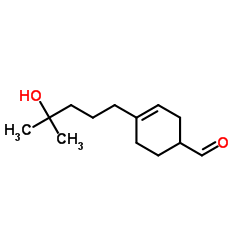Fragrance chemicals lyral and lilial decrease viability of HaCat cells' by increasing free radical production and lowering intracellular ATP level: protection by antioxidants.
Julnar Usta, Yassmine Hachem, Omar El-Rifai, Yolla Bou-Moughlabey, Karim Echtay, David Griffiths, Hania Nakkash-Chmaisse, Rajaa Fakhoury Makki
Index: Toxicol. In Vitro 27(1) , 339-48, (2013)
Full Text: HTML
Abstract
We investigate in this study the biochemical effects on cells in culture of two commonly used fragrance chemicals: lyral and lilial. Whereas both chemicals exerted a significant effect on primary keratinocyte(s), HaCat cells, no effect was obtained with any of HepG2, Hek293, Caco2, NIH3T3, and MCF7 cells. Lyral and lilial: (a) decreased the viability of HaCat cells with a 50% cell death at 100 and 60 nM respectively; (b) decreased significantly in a dose dependant manner the intracellular ATP level following 12-h of treatment; (c) inhibited complexes I and II of electron transport chain in liver sub-mitochondrial particles; and (d) increased reactive oxygen species generation that was reversed by N-acetyl cysteine and trolox and the natural antioxidant lipoic acid, without influencing the level of free and/or oxidized glutathione. Lipoic acid protected HaCat cells against the decrease in viability induced by either compound. Dehydrogenation of lyral and lilial produce α,β-unsaturated aldehydes, that reacts with lipoic acid requiring proteins resulting in their inhibition. We propose lyral and lilial as toxic to mitochondria that have a direct effect on electron transport chain, increase ROS production, derange mitochondrial membrane potential, and decrease cellular ATP level, leading thus to cell death.Copyright © 2012 Elsevier Ltd. All rights reserved.
Related Compounds
| Structure | Name/CAS No. | Molecular Formula | Articles |
|---|---|---|---|
 |
4-(4-Hydroxy-4-methylpentyl)cyclohex-3-enecarbaldehyde
CAS:31906-04-4 |
C13H22O2 |
|
Enhanced sensitization and elicitation responses caused by m...
2011-12-01 [Contact Dermatitis 65(6) , 336-42, (2011)] |
|
Can exposure limitations for well-known contact allergens be...
2011-06-01 [Contact Dermatitis 64(6) , 337-42, (2011)] |
|
Experimental elicitation with hydroxyisohexyl-3-cyclohexene ...
2007-03-01 [Contact Dermatitis 56(3) , 146-50, (2007)] |
|
[Current contact allergens].
2011-10-01 [Hautarzt 62(10) , 751-6, (2011)] |
|
Two fragrance chemicals may act as toxicants via TRPA1 stimu...
2013-09-01 [Toxicol. In Vitro 27(6) , 2022, (2013)] |